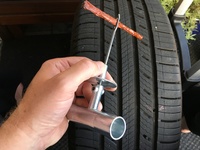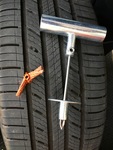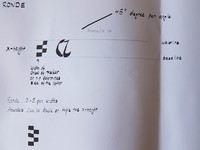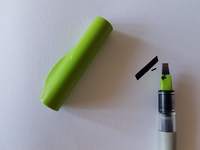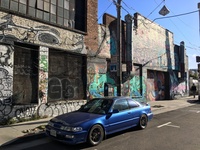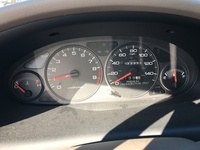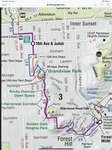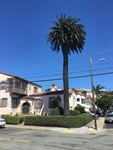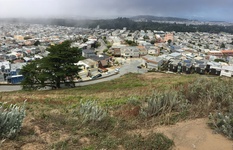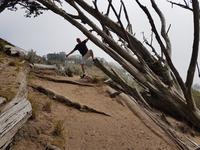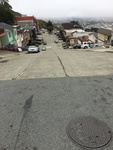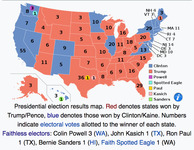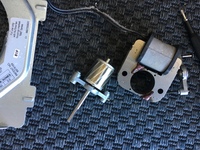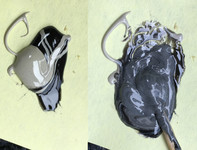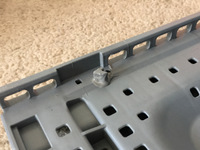 |
| Angelika/Mike Schilli |
Michael Somehow, Angelika and I have a special talent for constantly getting the tires of our cars flat. At least once a year, it happens that some screw or, recently in Angelika's case, even a part of a rusty old pair of scissors gets stuck in the tire, causing it to quickly deflate. Even in Germany, this happened to us two years ago during a visit. The rental car tire went flat, and we had to drive back to the branch at Munich Airport on the autobahn with the spare tire on, going 80 km/h. A true highlight of our driving skills!
The procedure for dealing with flat car tires is already routine for us here in the US: jack up the car, put on the spare tire, drive to the tire shop, and get it fixed. However, some American friends told me some time ago that you can also fix tires yourself here with repair kits that cost around 10 dollars. So, I preemptively ordered such a patch kit from Amazon and stored it carefully.
A few days ago, it finally happened: The Integra was noticeably tilted in the garage, and upon closer inspection, it turned out that the air had escaped from the right rear tire. A wood screw was deeply embedded in the tread, and I thought to myself: I'll try fixing this myself now.
The patch kit was held in a bright orange plastic box and contained two martial-looking corkscrew-like tools, along with about 40 pieces of what I call adhesive worms. These are brightly orange cotton cords, about 4 inches long and 1/4 inch thick, heavily coated with a very sticky adhesive. To repair the tire, you first remove the sharp object that caused the mishap, then you use the first corkscrew to pierce a hole and then roughen it with vigorous up-and-down movements, as the tool shaft has a fine grooved texture, like a file.
Then the repairman takes one of the 40 adhesive worms from the pack and symmetrically threads it into the second corkscrew, which has an eyelet at the bottom that opens up like a spring when pressure is applied downward. The tire repairman now folds the adhesive worm in the middle and forcefully stuffs it into the hole using the corkscrew, but not all the way to the end. Instead, he leaves about an inch of both sides of the adhesive-soaked cord sticking out at the top. Then he slowly and carefully pulls the corkscrew out upwards. As he does this, the eyelet of the corkscrew inside the tire opens up and releases the worm. The hole is thus plugged, and the resulting protrusion of the worm ends on the tire surface can either be trimmed with scissors or left as is to be smoothed out by tire wear during driving. Through the chemical miracle of vulcanization, the hole and the worm fuse into an airtight plug, and the tire is now airtight and repaired.
However, this method should only be used if the hole in the tire is not at the tire edge, because otherwise it could weaken the tire structure and lead to unsightly burst tires. Additionally, you can't accelerate to highway speeds with a patched tire, but in America, the speed limit is 75 mph max anyway. So far, the plug has held up well, and I still have 39 spare plugs left, so I'm ready for the next flat tire.
Angelika From our school days, everyone surely remembers the uplifting feeling of upcoming summer holidays. When all the exams were done and six long weeks of doing nothing and letting oneself drift lay ahead. As an adult, one rarely gets to enjoy this anymore. Semester breaks in college were not bad either, but for me, they were always filled with mandatory internships. But this summer, after decades, I finally had a long summer break again because I now work at a school, and even in the US, there are generous summer breaks or, more precisely, a stretch of time without classes. At our school, we had a whopping nine weeks off. It was wonderful. Just like in school days, there was nothing better for me than to read and immerse myself in the world of books. I had planned on reading a book every week during my time off, and I actually managed to do that. I read a colorful assortment of crime novels, non-fiction books, technical books, and, of course, novels.
Then I fulfilled my dream of attending a calligraphy course. I belong to a generation for whom learning cursive writing was a top priority in school. Unfortunately, this cultural technique is threatened with extinction, as it is believed that in the digital world, typing and print writing take precedence over cursive writing. In the US, many students no longer learn cursive because it has been removed from the curriculum. However, there is hope, as cursive writing is currently experiencing something of a comeback in schools here, since it has been found that it is not just about beautiful handwriting. Learning cursive not only helps with fine motor skills but also enhances memory and improves text comprehension. Students who write in cursive construct better texts than when they type them.
But I digress. My strict but fair elementary school teacher, Mrs. Hibben, not only ensured that we wrote all the loops, ascenders, and descenders in the correct order, but also insisted on good penmanship. In high school, my class teacher, Mr. Senst, was so impressed with my handwriting that he advised me to pursue a career in calligraphy. It's hard to believe that it took me decades to finally enroll in a course. I took this course as another class at the "Center for the Book" in San Francisco (Rundbrief 04/2007).
My writing attempts in the course strongly reminded me of my elementary school days. We learned the Ronde script, which originated in 16th century France and is relatively easy for beginners to learn. What fascinated me is that calligraphy is truly a science in itself. The type of script defines the letter size and the angle at which the writing tool must be held. Then there are all sorts of rules on how to connect the letters and, of course, a huge selection of different writing instruments, from fountain pens to nibs, to calligraphy pens with different nib widths. I particularly liked the so-called parallel pen, whose nib is not pointed at the front but broad, and which comes in different nib widths. In any case, the course was a lot of fun, and now it's clear that practice makes perfect.
Of course, I also used my summer vacation to complete various projects that I never have time for otherwise, and to visit family and friends. And just like that, the nine weeks were over, and the seriousness of life resumed.
Michael Recently, while visiting the grocery chain Trader Joe's, I remembered that I also wanted to get a duplicate of our apartment key made, and a sign in front of the adjacent store "Bed, Bath, and Beyond" indicated that this service was offered inside. I expected to find a cobbler in a small booth near the exit behind the registers who also offered key services, but instead, I saw -- a machine.
An old lady was just standing in front of it, the machine was humming busily and spat out a newly cut key into the output slot. She took it, exclaimed "nifty!" and toddled off. So I read the instructions on the touchscreen and followed the prompts to insert the key to be copied into a keyhole-like slot on the front of the machine, select the type of key (door key or car key), and pay the required $7.49 plus tax by credit card. Until now, I thought making a duplicate key only cost a few dollars, but apparently, the price for this service, like everything else here in the Bay Area (despite the government claiming barely noticeable inflation!), has tripled over the last 20 years. Oh well!
My email address was also requested by the machine, and it promised not to store my credit card information, otherwise a villain might find out which address the key fits into the lock. It also asked if I wanted to leave my fingerprint so it could store the key under it (what?), but I politely declined. The machine then started to rattle dangerously inside, and after about a minute, a newly carved golden door key fell into the output tray. I removed the old key and simply left the store with the duplicate, as the receipt was sent to me via email. The key was a bit sharp-edged, but it fit perfectly into the lock at home. Incredible, what these whippersnappers come up with these days! Such a machine would probably do well in Germany with its immense labor costs. However, Germans prefer significantly more complicated locks than Americans, who favor cheap good-enough solutions. But who knows, maybe something like this already exists over there!
Michael As a German expatriate, I often find myself in the absurd situation of having to explain to Americans that I do not see German vehicles as the be-all and end-all of the international automotive industry. When a sports car enthusiast colleague buys a BMW or Porsche, I can't help but think to myself: You fool! Why do you spend so much money on unnecessarily complicated frills that are also so hopelessly unreliable that the car spends more time in the workshop than thundering down the highway? I also hear horror stories from colleagues about overburdened Californian mechanics having to call Sindelfingen or Munich because completely trivial things break down, which then can only be fixed with special tools ordered straight from Mars, and which broke in the first place because they were developed by completely incompetent German engineers who seem to have lost the skill of designing reliable components.
I would also never buy a Tesla, simply because I need a car for driving, not a toy, I need a car that still runs even when there's no electricity available. But it's entertaining to watch how Tesla is giving German car manufacturers a run for their money because they aren't afraid to question everything that has existed so far and do things radically different, so much so that Tesla drivers rub their eyes in amazement and wonder why no one thought of this before.
Besides, what continues to deter me from buying new cars is the fact that car salespeople nowadays hardly make any profit from selling a vehicle. Instead, they speculate that the customer will constantly bring the car in for some costly "inspections," during which the dealer then "preventively" replaces perfectly functioning parts. Completely insane! These maintenance tasks, which the onboard computer demands every ten thousand miles, are utter nonsense and a money-making scheme. I know from car-loving colleagues that car dealers now charge extra if the buyer does not live in the nearby area. After all, they don't make any money from pointless inspections if the buyer is likely to have them done in their hometown.
For those who are interested: The maintenance cycle for our two cars looks like this: Oil is changed approximately every 5,000 miles, at the cheapest oil change provider for about 60 dollars. Otherwise, nothing is done unless something starts to rattle, squeak, or leak. Then I either fix it myself by purchasing the necessary replacement part from Amazon or an auto parts supplier, or, if the repair is beyond my knowledge, I take it to a Chinese mechanic in the Outer Mission neighborhood, whom I know to be reliable and honest. For a few hundred dollars, the man goes above and beyond.
With our aging 1998 Acura Integra, which at 21 years old will probably soon end up in the car graveyard, similar to its predecessor, a 1991 Integra, I find that interested buyers are mainly in the "Fast and Furious" bracket. Anyone who takes a look at the tachometer in figure 9 might notice that the red zone doesn't start until 8000 RPM. That's all I'm going to say about this. On YouTube, you can watch Brazilian race car driver Ayrton Senna, who tragically died in 1994, drive an Acura NSX between seven and eight thousand RPMs around a racetrack, wearing moccasins and white socks.
In San Francisco, these young car enthusiasts are called "Rice Boys," mostly Asian youths who race souped-up Hondas or Toyotas in so-called "sideshows" on deserted supermarket parking lots at night. Just like in the first part of the movie The Fast and the Furious in which, in the first street racing scene, a certain "Edwin" drives an Integra.
Unsurprisingly, these models are stolen like hotcakes, and for this reason, I recently personally installed a so-called "kill switch." This is a switch in a top-secret location that must be flipped for the fuel pump to start. Otherwise, the engine cranks endlessly and won't start even with a hot-wired ignition, causing thieves to get nervous, pull their hair out, and look for other targets.
Angelika We love hiking, and one of our favorite nature reserves, which is just about an hour's drive north of San Francisco, is Point Reyes (Rundbrief 04/2006). We drive up there regularly since we discovered it in 1994 during one of our West Coast trips. Since we now live in San Francisco, it is practically on our doorstep. Point Reyes has become increasingly popular and is unfortunately no longer a hidden gem. Even just 10 years ago, people would often ask in surprise where Point Reyes even was when we mentioned that we were going there. Nowadays, Point Reyes is especially popular with day-trippers from San Francisco and the Bay Area because it is easy to reach and offers beautiful hiking trails of varying difficulties and lengths.
Despite its staggering popularity, there are still ways to find paths that are not overcrowded. However, on the weekend when we visited Point Reyes once again, we made the mistake of taking a hiking trail that leads to a waterfall that cascades onto the beach. This is undoubtedly a unique natural spectacle, but we didn't actually want to go to the waterfall; we just wanted to go to Bass Lake, which is along the way.
We had walked this path many years ago, and this weekend we were feeling a bit sentimental and wanted to enjoy the hiking trail with its spectacular views of the Pacific Ocean once again. The fact that we had to park a mile away just to get to the trailhead should have given us pause. There were no parking spaces left at the official parking lot. Another clue was that Point Reyes staff were already directing traffic and assigning parking spots to drivers. However, this initially didn't deter us, as parking spaces at hiking trails are often limited and the crowds usually disperse quickly. Unfortunately, this time we were proven wrong, as it remained crowded and the stream of hikers from both directions did not let up.
We felt like we were in Disneyland. Shockingly, every third group of hikers was blasting music from their phones, not through headphones so that the rest of the world wouldn't have to listen. No, it echoed through the speakers into nature, which sounds totally tinny when you use a phone for that. I really thought I was in the wrong movie because, in all the many hikes we've done so far, we had never encountered this phenomenon before. I really enjoy listening to music, but everything in its own time. I don't need to be bombarded with sound when I'm moving through nature.
I was so confused by the experience that I did a bit of research, and indeed, the internet was full of complaints that this bad habit of playing loud music on hiking trails is spreading more and more. In fact, the first signs have already appeared in popular hiking areas asking people to refrain from doing so. It's sad that special signs are needed for this. The next day, we chose a less popular hiking trail and, lo and behold, apart from the sound of the ocean, the chirping of birds, and the rustling in the underbrush as a snake slithered away, as well as the footsteps of a few other hikers, we had the trail all to ourselves in complete silence.
Michael We have been living in San Francisco for the past 22 years, and during that time, we have always been on the lookout for secluded neighborhoods that no tourist has yet discovered. Apparently, there are more people like us, because a few months ago, the "Crosstown Trail Coalition," a committee of hiking enthusiasts, published the description of the San Francisco Crosstown Trails", a 20 mile long footpath through the city that passes by little-known attractions, even by local standards.
It begins at Candlestick Park in the far southeast of the city, winds his way through the somewhat more rustic neighborhoods of Bayview and Visitation Valley up to Bernal Heights, the home of our hippie millionaires. From there, hikers then trek through the middle class Glen Park and the affluent neighborhood of Forest Hill, to then pass through the Chinese Sunset District, to Golden Gate Park, and subsequently through the Presidio Park to the "Lands End" viewpoint at the far northwest of the city, to reach the ocean.
In doing so, the city explorer wanders through "Old Money" neighborhoods like Forrest Hill, where old mansions with a good 20 rooms stand on properties with generous driveways, and a Rolls Royce is parked out front. The path also leads over a no less than 30-feet-wide staircases between residential houses, but no one climbs the stairs because in this hilly area, no one walks. These staircases probably date back to times when city planners thought that within 50 years, a crazy hustle and bustle would ensue in Forest Hill, but instead, the area developed into a sleepy residential neighborhood for the super-rich.
Although these stairs often look like they belong to adjacent private residences, they are all public and curious individuals are allowed to use them as they please. They often connect rows of houses in hilly areas where city planners could not construct a direct connecting road due to the steepness of the slopes. The Crosstown Trail is designed to cover as many of these hidden stairs as possible, it seems to me.
The path offers beautiful views continuously, but of course, only if everything isn't fogged up again, which in San Francisco northwest of Twin Peaks is often hit or miss. As always, it is advisable to bring a warm jacket, just in case, because tourists frozen into icicles are repeatedly found along the way. We walked the Crosstown Trail in stages, and either took public transportation to the starting points or parked the car there and took an Uber back to the car after the stage.
Since there are no signs to outline the path, the hiker either uses the trail's smartphone app or prints out so-called cue sheets, which indicate at which street intersections to turn left or right, to follow the route. Nowadays, the Crosstown Trail is very popular, so you often see people sneaking through tiny residential streets with printed sheets of paper in hand, nodding knowingly when they see that you are also reading from a sheet of paper while walking.
Angelika We are in the middle of another election campaign. In 2015, when Trump appeared on the political stage, I still thought it was completely unthinkable that Donald Trump would ever become President of the United States. Four years later, I have to say that I fear we will probably have to brace ourselves for another term. I hope that I will be wrong again this time. Many Democratic voters are particularly frustrated with the American system of electors, because in two past elections (Bush vs. Gore and Trump vs. Clinton, see also Rundbrief 12/2000), in each case, a president made it to the White House even though the opposing candidate received more total votes from voters. Hillary Clinton received over 3 million more votes nationwide than Donald Trump, and yet Trump won. In America, it is not the direct votes of the population that count, but the electoral votes from the individual states.
Although populous states like California and Florida have more electors than sparsely populated ones, the number is determined by how many representatives the state has in the House of Representatives plus the Senate. Every state, regardless of size, sends 2 senators to the Senate, but based on population, a different number of representatives to the House of Representatives.
California, based on the last census in 2010, has exactly 53 representatives plus 2 senators, which results in California having 55 electors who vote for the president. Due to the knockout system applied in almost all states, the winner in each state receives all the electoral votes, even if the candidate wins by a narrow margin. This can lead to the described imbalance, where a candidate may receive the majority of votes nationwide but still not win. Many consider this undemocratic because ultimately not every voter's voice is considered. Furthermore, it leads to low voter turnout, as in states that always go to the candidate of the same party, the opposing side often doesn't bother to go to the polls because their vote changes nothing and is disregarded. This system also strengthens the electoral influence of states with lower population density, which in the U.S. are usually the more rural states that traditionally tend to give their votes to Republican candidates.
The Founding Fathers introduced the Electoral College as a compromise because many at the time were uneasy with the idea of the people directly electing the President and Vice President. However, they also did not want to transfer this responsibility to Congress, leading to the compromise of the Electoral College, established in "Article II, Section 1" of the American Constitution. Due to its entrenchment in the Constitution, it is not easy to get rid of the Electoral College system, as it requires a two-thirds majority in Congress.
This unusual election procedure leads to some absurdities in the campaign, such as politicians focussing on states that sometimes vote for the Republican candidate and other times for the Democratic candidate, the so-called "swing states." For example, since California has consistently voted for the Democratic candidate since 1992, no Republican candidate really campaigns there anymore.
The knockout system, in which all electoral votes go to the winner in the respective state, is not actually prescribed by the Constitution, and the states have a lot of leeway in this regard. Other models are and would be possible, such as a proportional distribution or a division based on the majority per electoral district, which is already done in the states of Nevada and Maine. Another initiative, according to which the electors give their vote to the candidate who receives the most votes on a national level, regardless of whether they won in their state or not, is currently being discussed as National Popular VoteInterstate Compact. Already, 16 states have committed or even passed corresponding laws in their respective parliaments to follow this procedure. Ultimately, this is an agreement between the states and an introduction of direct election through the back door, without having to amend the Constitution. However, for the whole thing to work at all, at least enough states would have to join the pact to reach the required majority of 270 electors. Currently, the states that have joined the pact only account for 196 electors. However, legal experts are debating whether these agreements might be unconstitutional or if approval from Congress would be needed to put the whole plan into action.
Another interesting fact is that nowhere in the Constitution does it state that electors must necessarily cast their vote for the candidate they were appointed to by the state. Theoretically, they can change their commitment and vote according to their conscience. However, individual states try to prevent this by selecting reliable and loyal electors or by imposing fines on those who deviate. A court of appeals in Denver, consisting of three judges, confirmed on August 20 that the respective states cannot force their electors to vote for a specific candidate. Many legal experts suspect that this question will ultimately be decided by the Supreme Court. Deviators are rather rare, but in the 2016 presidential elections, these so-called "Faithless Electors" caused a Democratic elector in Hawaii to vote for Bernie Sanders instead of Hillary Clinton, even though Sanders had already been eliminated in the primaries.
In the next newsletter, I will try to explain why I believe that Donald Trump will succeed again.
Michael In our household, things somehow keep breaking, but instead of replacing them with new ones, I often repair them with the help of my extensive tool collection. Recently, the bathroom fan stopped working. A new one costs only 15 dollars at the hardware store, but it was a lot of fun to take apart the electric motor, find the dirty axle, clean and lubricate it, reassemble the fan, and see that it now runs smoothly again. The knowledge gained from such a repair, as well as the excitement of whether you can even put the device back together, is priceless.
Often, when working on such tasks, it is necessary to glue broken plastic or metal parts back together. I don't know why, but somehow I seem to be at odds with superglues, as I have yet to find one that permanently sticks anything together. In the advertisements, it always looks so easy, but in reality, such a superglue at best permanently sticks to the repairer's fingers, while glued plastic parts bend like modeling clay under the subsequent application of force, and then come apart.
An American acquaintance gave me the tip to try the epoxy miracle adhesive "J-B Weld," which comes in two tubes. One contains a black paste called "Steel" (actually a resin), and the other a white goo called "Hardener." If you squeeze a small amount from both tubes onto a surface and mix them with a spatula, you get a gray paste that slowly hardens. It remains moldable for four to six hours, giving the repairer enough time to bond parts made of metal, PVC, ceramic, or wood. Within 15 hours, the paste fully hardens and bonds with the adjacent materials, creating something akin to a welded connection. I used it to firmly reattach the broken plastic tab from a folding crate, without which it wouldn't close properly (see Figure #1).
According to Wikipedia, the miracle paste was invented in 1968 by an American hobbyist, at the urging of his wife, turned it into a small business. The life dream of the company founder, who "suddenly" passed away in 1989, was allegedly to see an 18-wheeler truck on the roads of America loaded with nothing but J-B Weld. This American dream has come true, without a doubt.
Greetings!
Angelika and Michael



